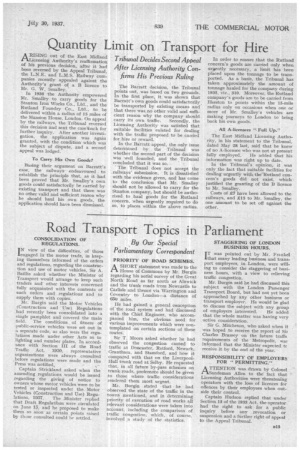Quantity Limit on Transport for Hire
Page 49

If you've noticed an error in this article please click here to report it so we can fix it.
Tribunal Decides Second Appeal After Licensing Authority Confirms His Previous Ruling
ARISING out of the East Midland Licensing Authority's reaffirmation of his previous decision, after it had been reversed by the Appeal Tribunal, the L.N.E. and L.14I.S. Railway companies recently appealed against the Authority's grant of a B licence to Mr. G. W. Smalley.
In 1936 the Authority empowered Mr. Smalley to carry goods for the Stanton Iron Works Co., Ltd., and the Rutland Foundry Co., Ltd., to be delivered within a radius of 15 miles of the Mansion House, London. On appeal by the railways, the Tribunal reversed this decision and sent the ca.seNback for further inquiry. After another investigation, the application was again granted, with the condition which was the subject of dispute, and a second appeal was lodged.
To Carry His Own Goods? • Basing their argument on Barra_tt's case, the railways endeavoured to establish the principle that, as it had been proved that Mr. Smalley's own goods could satisfactorily be carried by existing transport and that there was no other valid and sufficient reason why he should haul his own goods, the application should have been dismissed. The Barrett decision, the Tribunal points out, was based on two grounds. In the first place, it was shown that Barratt's own goods could satisfactorily be transported by existing means and that there was no other valid and sufficient reason why the company should carry its own traffic. Secondly, the Licensing Authority was satisfied that suitable facilities existed for dealing with the traffic proposed to be carried for hire or reward.
In the Barratt appeal, the only issue determined by the Tribunal was whether the second part of the decision was well founded, and the Tribunal concluded that it was so. • The Tribunal does not accept the railways' submission. It is dissatisfied with the evidence given, and has come to the conclusion that Mr. Smalley should not be allowed to carry for the Stanton company, but should be authorized to haul goods for the Rutland concern, when urgently required to do so, to places within the above radius. In order to ensure that the Rutland concern's goods are carried only when urgently necessary, a limit has been placed upon the tonnage to be transported. As a basis, the Tribunal has taken approximately the amount of tonnage hauled for the company during 1935, viz., 310. Moreover, the Rutland company's goods are to be carried from Ilkeston to points within the 15-mile radius only on occasions when one or more of Mr. Smalley's vehicles are making journeys to London to bring back his own goods.
All A-licensees ". Full Up."
The East Midland Licensing Authority, in his statement to the Tribunal, dated May 28 last, said that he knew of no A-licensee who was not at present fully employed. He added that his information was right up to date.
In the Tribunal's opinion, it was only the fact that suitable facilities for dealing urgently with the 'Rutland concern's goods did not exist, which justified tbe granting of the B licence to Mr. Smalley.
Costs of £7 have been allowed to the railways, and £15 to Mr. Smalley, the one amount to be set off against the other.




















































































